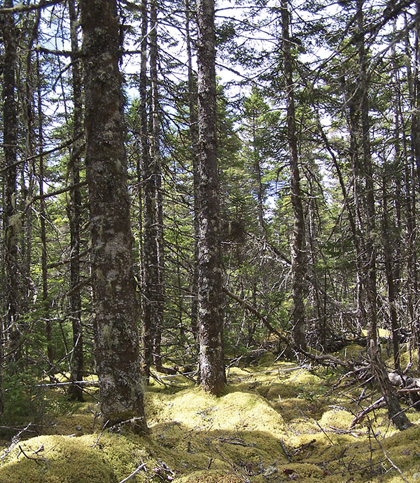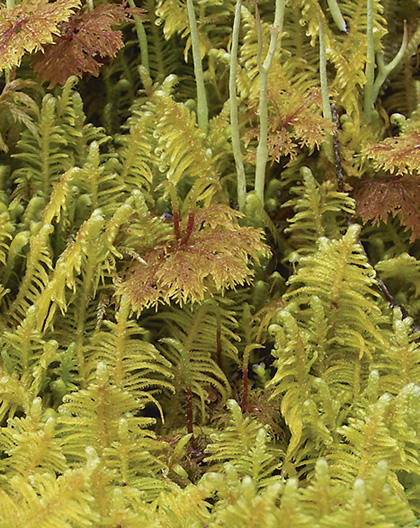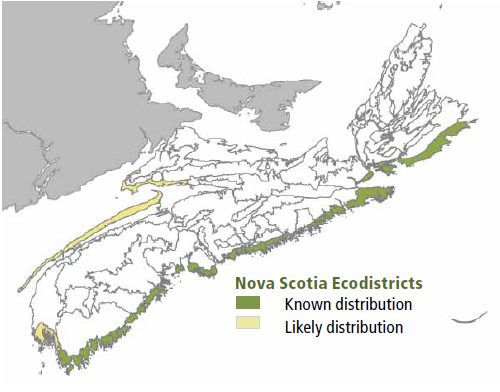
Forest Vegetation types - CO1
CO1 — Black spruce - Balsam fir / Foxberry / Plume moss
Picea mariana - Abies balsamea / Vaccinium vitis-idaea / Ptilium crista-castrensis
 |
| Second Lake, Halifax County |
Concept: This edaphic climax Vegetation Type (VT) has an overstory dominated by black spruce and balsam fir. White spruce may also be common in western parts of the province. Coniferous tree species regeneration and moss cover are usually extensive. Black spruce - Balsam fir / Foxberry / Plume moss represents the dominant forest found on fresh-moist, nutrient poor coastal sites in Nova Scotia.
Vegetation: Black spruce and balsam fir are the dominant overstory trees, with lesser amounts of white spruce and tamarack. (White spruce may be more common in western Nova Scotia, where balsam fir cover is reduced.) Scattered red maple and white birch (if present) are typically in an intermediate canopy position. The shrub layer is dominated by regenerating balsam fir and/or black spruce along with lambkill. Other common shrub species include wild raisin, false holly and mountain-ash. Herb layer diversity is low, with bunchberry, creeping snowberry and twinflower often dominant. Scattered foxberry can also be found, with cinnamon fern also common on wetter sites. Schreber's moss dominates the extensive bryophyte layer with lesser amounts of stair-step moss, bazzania and plume moss.
Environmental Setting: CO1 is mainly associated with fresh-moist to moist, nutrient poor soils of glacial origin. These soils are generally medium to coarse textured and are often stony. The majority of this VT is found in the Atlantic Coastal ecoregion. High winds and exposure limit tree height potential in CO1 stands. This VT likely occurs in coastal areas of both New Brunswick and Prince Edward Island, but has not been documented.
Successional Dynamics: This VT has nutrient poor soils that give rise to an edaphic climax community dominated by black spruce and balsam fir. The even-aged forest typically follows stand-replacing disturbances such as windthrow, breakage, insect infestation and harvesting. In the absence of these types of disturbances, black spruce and balsam fir in this ecosystem are expected to live to about 100 years, after which tree senescence will initiate renewal through advanced regeneration. Due to its unique ecological setting, CO1 does not usually shift to other vegetation types after disturbance. However, on higher fertility sites, CO1 may succeed from (or revert to) CO4 (Balsam fir / Foxberry - Twinflower). Between stand-level disturbances, natural tree senescence can create uneven age class distribution and other stand structures.
Ecological Features: This closed canopy matrix forest is primarily associated with the Maritime Boreal Atlantic Coastal ecoregion. The forest's longevity is a function of either canopy tree senescence or the frequency of catastrophic stand disturbances (usually hurricanes). Stands near the coast or on islands are used as nesting sites and roosts for great blue herons and various seabirds. Coastal forests are often used by songbirds as they travel along the coast during spring and fall migration. Mature forests develop abundant old man's beard, a lichen that provides important nest material for warblers and other species, and winter food for deer grazing on fallen trees. Old, undisturbed stands with balsam fir may house the endangered boreal felt lichen and other uncommon cyanolichens.
 |
| Plume Moss |
Distinguishing Features: This coastal softwood forest has abundant black spruce in the overstory. Mountain-ash, heart-leaf birch, foxberry and bazzania are indicators of a coastal influence, though they are not always present. Extensive moss coverage and a thick duff layer characterize the forest floor.
| Slope Position: | Upper5 Middle3 Level2 |
Surface Stoniness: |
(Very - Excessively)4 (Non - Slightly)3 (Moderately)3 |
Bedrock Outcrop: |
(Non-rocky)8 (Slightly - Moderately)1 (Very - Excessively)1 |
Elevation Range: |
8 - 116m |
Slope Gradient: |
Gentle7 Level2 Moderate1 |
Aspect: |
North4 East3 South1 West1 None1 |
Exposure: |
Exposed8Mod. exposed2 |
Microtopography: |
Slightly6Level4 |
Drainage: |
Imperfect7 Moderately well3 |
Soil Type: |
ST34 ST3-L3 ST62 ST2-L1 |
Parent Material: |
Glacial till9 Till/Bedrock1 |
Rooting Depth (cm): |
(<30)7 (30-45)3 |
Duff Thickness (cm): |
(11-20)7 (21-40)3 |

